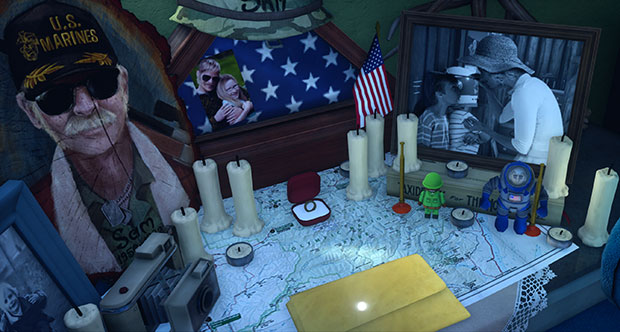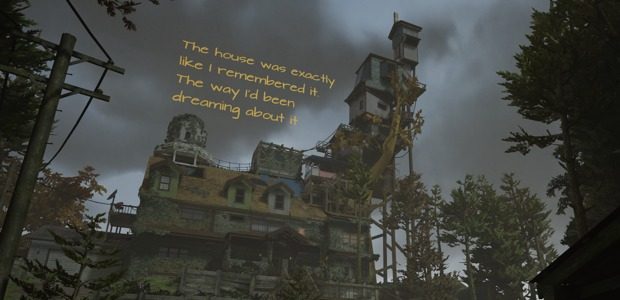THE HIGHS
Tom Senior: Home again‘Oh another twee game about walking around a sad house’ I thought as I started up What Remains of Edith Finch for the first time. For five minutes the game stuck to type. The narrator spoke evocatively of old memories and family secrets. Cold sunlight fell artfully through leafy branches. There were violins. It was familiar.
But then I looked up and saw the house itself—a demented construct that looks like a country mansion mashed into a vertical shanty town. Then I looked down and realised ‘oh snap, I’m pregnant!’ Fifteen minutes later I was diving into the diary of a lost family member, zooming into her world and exploring the house and the surrounding countryside from her perspective. It was still sentimental, sure, but it was also sinister, and intriguing. The beautifully modelled house is full of trick doors and hidey holes. The game is resolutely linear, but I still felt like a trespasser sneaking into locked away memories. I won’t spoil any more, but it’s the best entry in the sad house genre since the sad house genre was invented by Gone Home a few years ago.
Joe Donnelly: Into the wilder-yesSort of similar to Tom, I was sent a copy of Marshlight Software's narrative adventure game The Edgelands this week and wasn't immediately taken by it. As one of Failbetter's fundbetter initiative games, I'd had my eye on this 'un for a while but was immediately disappointed in its well-worn amnesiac protagonist introduction. Before long, though, I was out exploring its fantastical world, conversing with its bizarre and outlandish characters, and fumbling through its narrative-led puzzles. Against some striking visuals, and a killer soundtrack, my initial disdain was quickly reversed and I'm now very much looking forward to spending some more time with it this weekend.
As I mentioned in my news write-up, its creator cites Infocom-era gamebooks as a central source of inspiration, but its offbeat world also echoes that of Kentucky Route Zero's—which is easily one of the best modern examples of the genre. The Edgelands is due on May 9, and while I don't know how much it'll sell for yet, I'd certainly recommend it as one to watch out for—particularly if, like me, you're of the adventure game persuasion.
Wes Fenlon: Old questionsI love digging into the minutiae of game history, and I got to do a lot of that, recently, in the process of writing about Final Fantasy 7's 1998 PC port. I initially planned to write something about the difficulty of porting a console game to PC 20 years ago, but after researching the port's differences from the PlayStation version, I became obsessed with one particular feature: the mouths added to the characters. Nothing else about the character models or designs was changed, but everyone got a mouth! Weird, right? I thought so, and I tracked down some of the developers to find out why. Curiosity is the best research fuel.
Tyler Wilde: Farm lifeThis guy bought a farm to live out his Stardew Valley dreams. I don’t have enough money to buy a farm, and obviously many don’t, so I’m not going to say this is some universal inspiration we should all follow. But I will say that it rules. If you could, how would you live your videogame fantasies? I’m not that into farming games, so I’d probably just buy a car and strap rockets to it and that would be the end of me. It’s probably best that I don’t. But farm guy, he’s still onto something.
Tim Clark: Go into the lightNormal service resumes this week, which means brace yourselves for more Hearthstone talk from me. It’s a relief to have finally published my thoughts on Un’Goro, which I like a lot, despite some concerns about the cost of staying competitive. I also notched up my fourth golden hero, and despite being the wrong side of 40, still get a dumb thrill from playing with Uther’s animated portrait. (Even if it wasn’t quite the as good as the first time.) Really though, I’m just pleased that Paladin is good again. I have long been of the view that Midrange Pally is the only honest and true deck in Hearthstone, so it was painful seeing the class reduced to a shadow of itself prior to Un’Goro. But cards like Hydrologist and Sunkeeper Tarim (my new favourite legendary) have helped Paladin’s board-centric game massively. If you’re looking for a good version to try, check this list out from Jab. Just beware of all the crabs.
Chris Livingston: Far High 2 Yeah, I'm back playing Far Cry 2 again. I needed a screenshot of something for a feature I'm working on, so I reinstalled it and hopped in for what could have been a quick thirty seconds but instead became about two hours. And damn do I love being in that harsh, deadly, unforgiving world once more. I'm aware of—and agree with—most of the complaints about the open-world FPS, but it's still one of my favorite games and favorite places to be. I didn't even do much—just drove around and got into a few firefights, but I loved every second of it. Also, I forgot to get the screenshot I went there for in the first place, so looks like I'll have to play some more this weekend. Not a problem.
THE LOWS
Tyler Wilde: Duty callsAs a shooter fan, I’m glad Call of Duty is returning to World War 2, and I hope the shift means less focus on gadgets and more on basic level and weapon design. But as a person who regularly has to parse marketing speak, I’m exhausted. The reveal livestream was one of the more embarrassing I’ve seen in a long time, not because it wasn’t well-produced or Call of Duty: WWII doesn’t look good—though I haven’t really liked a Call of Duty for a while—but because Activision has pre-emptively decided that it’s a cultural achievement, a documentary of sorts with such attention to historical accuracy that it has the power to prevent future wars. I’ll call bullshit on that in more words elsewhere, but the short of it is: No, I don’t think Call of Duty: WWII is those things.
Tim Clark: Souls outAnd so it’s over. My buddy Dave and I carried each other limping, crying, and arguing about strats over the line in Dark Souls 3’s The Ringed City DLC. Now there is no more. (For the record I landed the final blow on the boss both times, you’re welcome Dave.) The Ringed City was a decent send off for a sensational game, even if the ending didn’t resonate especially deeply with me. I think the weight of having to wrap up such a big series was always going to hang a little heavy on what is, after all, an addendum more than an expansion.
For Dave and I, co-op play was primarily a way of catching up, because both of us prefer to talk on Skype while playing something rather than endure the awkwardness of actual phone calls. For me it also meant a relatively easy way into a game that prides itself on not babying new players. If Miyazaki is to be believed, and this really is the end for the series, (he probably isn’t, it probably won’t be), then I’m going to need a new game to stay in touch with Dave. Suggestions below, please.
(Hey everyone, it's James. Tell Tim to play Bloodborne already.)
Chris Livingston: Language, pleaseI played Pinstripe this week, an adventure platformer about trying to rescue your daughter from hell. It's pretty darn spooky in parts, and more than a bit morbid—I might even categorize it as horror. Mr. Pinstripe himself is unsettling and genuinely scary the first few times you encounter him, until he very suddenly isn't because he calls you, and I quote, "douche."
Douche? It's a weird thing for a hellish spectre who has stolen your daughter to say and completely deflates any fear I had of him as an adversary. Perhaps it was an attempt at humor—and there's nothing wrong with adding some levity to horror now and then—but it really shattered the mood and the moment. It's like if Anton Chigurh, instead of saying "Call it, friend-o" had said "Call it, fart-breath." Menace can evaporate instantly, simply due to a poor choice of words. Or, in this case, word.
Wes Fenlon: Net not so neutralI have a feeling this is going to be a recurring low for me for the rest of 2017. The FCC recently rolled back privacy protections for internet users, and it's now proposing to kill net neutrality under the guise of a proposal named "Restoring Internet Freedom." What it really aims to restore is more freedom for the multi-billion dollar corporations that already have a stranglehold on the internet infrastructure of most of the US. The creator of the world wide web has already spoken out against the proposal. Hopefully thousands or millions of Americans adding their voice to hise might make the FCC reconsider.
Tom Senior: How games dieHow many virtual trees have been made by game artists in the history of the medium? How many brick wall textures? How many longswords? Imagine the millions of hours that people in different studios have funnelled into making the same objects over and over. It’s incredible how much work is repeated and wasted during the creation of the game worlds we enjoy.
So much of it ends up in the bin. This week Diablo 2 mastermind David Brevik worried that many of the original Diablo 2 assets may have been lost, making a remaster more difficult. It reminded me that for every little piece of art, modelling or music that makes it into a published game, more are lost to cancelled projects. Even in successful games, the original files vanish—why spend money to sustain legacy servers for assets that are unlikely to ever be used again? Digitisation has saved old film, music, television and literature from the degradation of physical media, but in the digital environment games can easily fade and die, becoming incompatible as software moves on. Perhaps one day all that will remain of the games we love today will be the words that celebrated them on sites like PCGamer.com. Hopefully not, though.
Joe Donnelly: Punch drunkIn this week's more bizarre-leaning news, it seems boxing kangaroo Roger Jr won't feature in the incoming western interpretation of Tekken 7. Why? Well, I'm not entirely sure. Speaking to VG24/7 it seems executive producer Katsuhiro Harada is preempting "animal activists" from complaining by omitting the fighting macropod, yet is leaving Kuma the bear in place because he’s "obviously stronger than a human being".
Here's Harada's rationale for Roger's removal: "There was a video of a man’s dog being headlocked by a kangaroo, and he punched it in the face. It turned into a big problem. People were complaining about him punching a kangaroo. It seems that in the last few years there’s a lot more animal activists—even though they probably wouldn’t play our game they would still hear about that, about a kangaroo in our game being punched, and would complain about it."Now, I'm by no means supporting organisations like PETA's involvement in videogames over the last several years, but in their defence it seems Harada et al have jumped the gun in this instance. What's your take?












